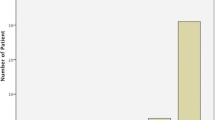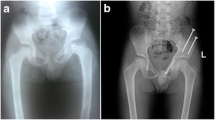Abstract
This article presents the results of Legg-Calve-Perthes (LCP) disease treatment using triple pelvic osteotomy. Thirty patients were analysed. The conditions for inclusion in the study were complete medical documentation and follow-up until the disease was resolved. Postoperatively, no patients were immobilised. Rehabilitation was initiated early in all patients, and full weight bearing was allowed after ten weeks. With this method, an increase of the CE angle of 17.43 ± 4.020° was achieved. Containment was increased from an initial 6.67% to 53.33% of patients at the final check-up. Similar improvement was achieved by using Herring classification of the damage; preoperatively most hips belonged to group C, and postoperatively to group A. Postoperatively, functional results were also considerably improved. The authors recommend triple pelvic osteotomy as the method of choice in the treatment of severe cases of LCP disease.
Resumé
Les auteurs présentent les résultats de la maladie de LCP traitée par triple ostéotomie pelvienne. 30 patients ont été analysés. Les conditions d’inclusion ont été les possibilités d’analyser de façon complète tous les documents avec une pathologie soit en fin d’évolution. En post-opératoire aucun des patients n’a été immobilisé et tous ont bénéficié d’une rééducation précoce avec un appui complet à 10 semaines. Cette méthode montre une amélioration de l’angle CE de 17.43±4.020°. La congruence s’est améliorée de 6,67% à 53,33% à la dernière revue. Une amélioration indentique a été retrouvée avec la classification de Herring avec une majorité de hanche en C préopératoire et en A post-opératoire. De même, en ce qui concerne les résultats fonctionnels. Les auteurs pensent que la triple ostéotomie pelvienne est une méthode de choix dans le traitement des lésions sévères de la maladie de LCP.




Similar content being viewed by others
References
Carlioz H (2000) Pelvic osteotomies in children and adolescents. Acta Orthop Belg 66:321–328
Catterall A (1981) Legg-Calve-Perthes syndrome. Clin Orthop Relat Res 158:41–52
Clohisy JC, Nunley RM, Curry MC, Schoenecker PL (2007) Pariacetabular osteotomy for the treatment of acetabular dysplasia associated with major aspherical femoral head deformities. J Bone Joint Surg Am 89:1417–1423
Dal Monte A, Sonicini G, Valdiserri L (1980) Acetabuloplasty by triple pelvic osteotomy: indications and surgical technique. Ital J Orthop Traumatol 6:5–18
Dogan A, Zorer G, Ozer UE (2007) Treatment of acetabular dysplasia by triple pelvic osteotomy and its short-term results. Acta Orthop Traumatol Turc 41:355–366
Frick SL, Kim SS, Wenger DR (2000) Pre-and postoperative three-dimensional computed tomography analysis of triple innominate osteotomy for hip dysplasia. J Pediatr Orthop 20:116–123
Grzegorzewski A, Bowen JR, Guille JT, Gluttung J (2003) Treatment of the collapsed femoral head by containment in Legg-Calve-Perthes disease. J Pediatr Orthop 23:15–19
Guille JT, Forlin E, Kumar SJ, MacEwen GD (1992) Triple osteotomy of the innominate bone in treatment of developmental dysplasia of the hip. J Pediatr Orthop 12:718–721
Hailer NP, Soykaner L, Ackermann H, Rittmeister M (2005) Triple osteotomy of the pelvis for acetabular dysplasia: age at operation and the incidence of nonunions and other complications influence outcome. J Bone Joint Surg Br 87:1622–1626
Harris WH (2001) My first 50 years of orthopeadic surgery. J Arthroplasty 16(8 Suppl 1):2–7
Hefti F, Clarke NMP (2007) The management of Legg-Calve-Perthes disease: is there a consensus? J Child Orthop 1:19–25
Herring JA, Kim HT, Browne R (2004) Legg-Calve-Perthes disease. Part I: classification of radiographs with use of the modified lateral pillar and Stulberg classifications. J Bone Joint Surg Am 86:2103–2120
Herring JA, Kim HT, Browne R (2004) Legg-Calve-Perthes Disease. Part II: prospective multicenter study of the effect of treatment on outcome. J Bone Joint Surg Am 86:2121–2134
Huang MJ, Huang SC (1999) Surgical treatment of severe Perthes disease: comparison of triple osteotomy and shelf augmentation. J Formos Med Assoc 98:183–189
Jawish R, Ghorayeb J, Khalife R (2007) Quadruple and juxta-articular pelvic osteotomy in children using anterior approach: technique and results. J Pediatr Orthop B 16:10–15
Kirschner S, Raab P, Wild A, Krauspe R (2002) Clinical and radiological short-and mid-term results of triple pelvic osteotomy according to Tonnis in adolescents and adults. Z Orthop Ihre Grenzgeb 140:523–526
Kumar D, Bache CE, O’Hara JN (2002) Interlocking triple pelvic osteotomy in severe Legg-Calve-Perthes Disease. J Pediatr Orthop 22:464–470
Lin CJ, Huang SC, Liu TK (1992) Surgical treatment for Perthes disease at risk. J Formos Med Assoc 91:424–431
Lipton GE, Bowen JR (2005) A new modified technique of triple osteotomy of the innominate bone for acetabular dysplasia. Clin Orthop Relat Res 434:78–85
Poul J, Vejrostova M (2001) Triple osteotomy of the pelvis in children and adolescents. Acta Chir Orthop Traumatol Cech 68:93–98
Stulberg SD, Cooperman DR, Wallensten R (1981) The natural history of Legg-Calve-Perthes disease. J Bone Joint Surg Am 63:1095–1108
Tschauner C, Sylkin A, Hofmann S, Graf R (2003) Painful nonunion after triple pelvic osteotomy. Report of five cases. J Bone Joint Surg Br 85:953–955
Von Bremen-Kuhne R, Vega-Salgado H, Steffen R (2006) Triple pelvic osteotomy (according to Tonnis and Kalchschmidt) in the treatment of acetabular dysplasia-medium-term results. Z Orthop Ihre Grenzgeb 144:484–491
Vukašinović Z, Slavković S, Miličković S, Siqeca A (2000) Combined Salter innominate osteotomy with femoral shortening versus other methods of treatment for Legg-Calve-Perthes disease. J Pediatr Orthop B 9:28–33
Vukašinović Z, Spasovski D (2006) Triple pelvic osteotomy-complications and how to avoid them. Srp Arh Celok Lek 134:49–53
Author information
Authors and Affiliations
Corresponding author
Rights and permissions
About this article
Cite this article
Vukasinovic, Z., Spasovski, D., Vucetic, C. et al. Triple pelvic osteotomy in the treatment of Legg-Calve-Perthes disease. International Orthopaedics (SICOT) 33, 1377–1383 (2009). https://doi.org/10.1007/s00264-009-0745-x
Received:
Revised:
Accepted:
Published:
Issue Date:
DOI: https://doi.org/10.1007/s00264-009-0745-x




